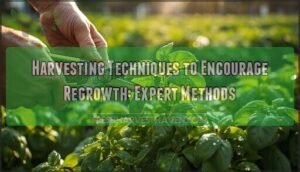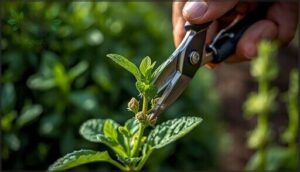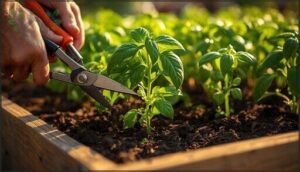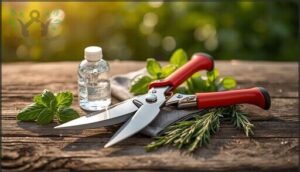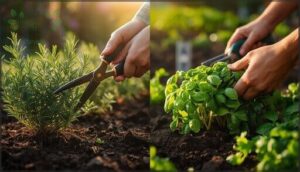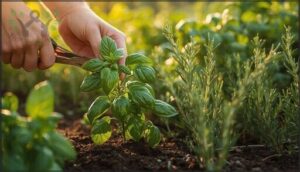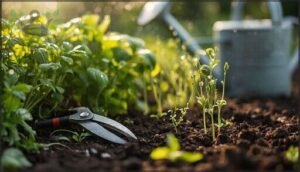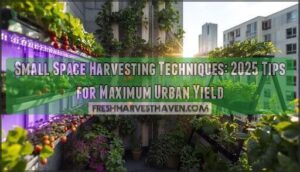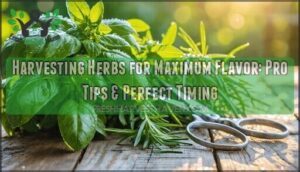This site is supported by our readers. We may earn a commission, at no cost to you, if you purchase through links.
Most gardeners harvest their herbs the same way they pick flowers—snipping off whatever looks good without much thought. Then they wonder why their basil turns leggy, their mint stops producing, or their cilantro bolts straight to seed.
The difference between a plant that limps along and one that explodes with fresh growth comes down to where, when, and how you make your cuts. Strategic harvesting techniques to encourage regrowth transform your herb garden from a one-time harvest into a productive system that keeps delivering throughout the season.
By understanding plant physiology—specifically how herbs respond to pruning stress and redirect their energy—you can trigger lateral branching, prevent premature flowering, and multiply your yield without planting a single additional seedling.
Table Of Contents
- Key Takeaways
- Key Factors Affecting Herb Regrowth
- Best Times to Harvest for Regrowth
- Pinch and Prune Techniques Explained
- Cut-and-Come-Again Harvesting Method
- Essential Tools for Effective Harvesting
- Harvesting Perennial Vs Annual Herbs
- Sustainable Harvesting Practices
- Techniques to Maximize Leaf Production
- Propagation From Harvested Cuttings
- Post-Harvest Care for Vigorous Regrowth
- Frequently Asked Questions (FAQs)
- How can i Improve my herb garden?
- Why should you harvest your herbs?
- How do you harvest herbs?
- Should you harvest herbs before or after flowering?
- How do I know if my herbs are ready to harvest?
- How do I get the best out of my herb garden?
- Can you harvest herbs during drought conditions?
- How does mulching affect herb regrowth rates?
- Should you harvest flowering herbs differently?
- Do companion plants improve herb regrowth speed?
- Conclusion
Key Takeaways
- Strategic harvesting above leaf nodes triggers hormonal responses that redirect plant energy from vertical growth into lateral branching, effectively doubling your harvest potential when you consistently remove 50-75% of foliage while leaving at least one-third of the plant intact for recovery.
- Timing your harvest during morning hours when essential oils peak—and before flowering begins—preserves maximum flavor concentration while preventing the energy shift toward seed production that reduces both leaf quality and regrowth vigor.
- Annual herbs like basil respond to aggressive weekly harvesting that delays bolting and extends productive cycles by 10-14 days, while perennials require gentler treatment with minimum one-week recovery windows and complete dormancy-season rest to maintain multi-year productivity.
- Post-harvest care determines regrowth success: immediate watering every three days combined with 100-150 ppm nitrogen fertilization within 48 hours accelerates recovery, while proper tool sterilization between cuts prevents disease transmission that can set plants back for weeks.
Key Factors Affecting Herb Regrowth
Understanding what drives herb regrowth is the first step toward a more productive harvest. Your herbs respond to a complex interplay of biology, environment, and care—and knowing these factors helps you work with the plant rather than against it.
Let’s break down the key influences that determine whether your herbs bounce back vigorously or struggle after you’ve made your cuts.
Growth Cycles of Annual Vs Perennial Herbs
Understanding herb life cycles shapes your entire harvesting strategy. Annual herbs like basil complete their growth cycle—germination, leaf production, flowering, and seed production—within one season, then die. They won’t regrow once you’ve pulled them out. Perennials such as thyme and oregano, however, return year after year from established roots. To boost yields, consider the herb garden location for best growth.
- Annuals require replanting each season but offer quick harvests
- Perennials take longer to establish yet provide multiple years of regrowth
- Growth patterns differ: annuals race toward seed production while perennials focus on sustained leaf regeneration
Environmental Influences on Regrowth
Your herb’s environmental adjustments directly impact regrowth success. Light quality drives photosynthesis—aim for full intensity to boost biomass production. Soil temperature affects root activity and nutrient uptake, while water stress (both drought and excess) reduces leaf area and growth cycles.
High humidity levels invite disease, so secure proper air circulation around your plants. A plant’s leaves contain stomata for gas exchange, which affects water vapor and carbon dioxide levels.
These sustainable harvesting considerations support vigorous plant growth and postharvest care outcomes.
Importance of Soil and Water Quality
Your soil composition forms the foundation for herb regrowth. Nitrogen, phosphorus, and potassium fuel growth cycles, while microbial activity unlocks nutrients your roots need.
Water purification matters too—high salinity blocks nutrient uptake and stresses plants. Test your soil regularly to maintain nutrient balance, and match watering practices to your herb’s needs.
Sustainable gardening starts below ground, where soil health and root health determine plant health outcomes.
Best Times to Harvest for Regrowth
Timing your harvest correctly can make the difference between a thriving herb garden and one that struggles to bounce back. You’ll want to factor in not just the season, but also the plant’s growth stage and even the time of day you’re cutting.
Let’s look at three key timing factors that directly affect how quickly and vigorously your herbs regrow.
Seasonal Timing for Optimal Regrowth
When you align harvest scheduling with seasonal cycles, you’re working with nature’s rhythm rather than against it. Different growth stages and climate effects directly shape regrowth patterns, so timing matters more than most gardeners realize.
Key seasonal harvesting windows include:
- Spring to early fall: Annual herbs like basil and cilantro thrive during their active growing season until frost
- Mid-summer peak: Essential oil concentration hits maximum levels just before or during early flowering
- Late August cutoff: Stop harvesting perennials about one month before expected frost to prevent winter damage
- Cool-season windows: Harvest parsley and cilantro in early spring or fall to avoid heat-induced bolting
Sustainable harvesting techniques depend on understanding these growth cycles. You’ll optimize regrowth by matching your cuts to each herb’s natural calendar.
Identifying Harvest-ready Herbs
You’ll know your herbs are ready when leaves reach full size—usually at 4–6 inches tall— with firm stems and a telltale sheen indicating peak oil content.
Leaf quality matters: vibrant, glossy foliage signals ideal harvest timing, while dull leaves suggest declining flavor.
Visual signs like unopened flower buds mark the sweet spot for cutandcomeagain harvesting techniques, capturing growth stages when regrowth indicators promise vigorous leaf production ahead.
Morning Vs Evening Harvesting
Timing your harvest around circadian rhythm dramatically impacts essential oils and flavor profiles. Morning harvesting consistently outperforms evening cuts:
- Regrowth rates accelerate by up to two days when you harvest during peak leaf turgor
- Essential oil retention stays 25% higher in morning-collected basil and mint
- Shelf life extends 30% longer with early harvest timing
These harvesting techniques support continuous harvest cycles and optimize regrowth potential.
Pinch and Prune Techniques Explained
You’ve got two powerful techniques at your fingertips—pinching and pruning—that can transform leggy, sparse herbs into full, productive plants. The key is knowing when and how to apply each method to trigger the right growth response.
Let’s break down the practical steps that turn these simple cuts into bushy, high-yielding herb gardens.
How to Use The Pinch Method
You’ll transform your herb plants from scraggly to lush when you master the pinch technique. Locate the node—those small bumps where leaf pairs emerge—and position your fingers or clean snips just above it. Remove the top growth, and you’ll trigger lateral branching that doubles your harvest potential. Start when plants reach 4-6 inches tall with at least four mature leaves.
This stem removal method redirects energy from vertical growth into leaf production, giving you that coveted bushy appearance. Your basil, mint, and thyme respond particularly well to consistent pinching throughout the growing season, delivering tender, flavorful leaves all summer long.
| Growth Stage | Pinch Location | Expected Response |
|---|---|---|
| 4-6 inches tall | Just above leaf node | Two new lateral stems emerge |
| 8-12 inches tall | Multiple node points | Bushier, fuller plant structure |
| Early season | Top growth removal | Delayed flowering, extended harvest |
| Mid-season | Regular pinch points | Continuous leaf regrowth |
| Every few weeks | Active growth nodes | Maximum harvestable foliage |
Pruning for Bushier Growth
Strategic pruning techniques fundamentally reshape your herb’s architecture by removing apical meristems—the growth points at stem tips—which triggers cytokinin release in dormant lateral buds.
You’ll see stem pruning transform leggy specimens into bushy plants when you cut just above nodes at 8 cm height, boosting biomass regeneration up to 400%.
Clean, angled cuts made with sanitized shears accelerate leaf regeneration while promoting vigorous regrowth techniques through enhanced lateral branching and improved plant training outcomes.
Benefits of Regular Pinching
Regular pinching fundamentally enhances your herb’s productivity through three measurable mechanisms:
- Enhanced lateral growth—increasing branch formation by up to 45%, directly boosting harvestable biomass
- Improved nutrient uptake—with auxiliary shoots showing 31% higher nitrogen and calcium allocation
- Delayed flowering—extending vegetative harvest windows by 10-14 days
These regrowth techniques maximize continuous harvest while improving overall plant vigor and market quality.
Cut-and-Come-Again Harvesting Method
The cut-and-come-again method offers a more aggressive approach than simple pinching, allowing you to harvest substantial quantities while stimulating vigorous new growth. This technique works by cutting the entire plant back to about an inch above the soil line, which triggers a flush of fresh shoots from the base.
Let’s walk through how to apply this method effectively, which herbs respond best to this treatment, and what you can expect during the recovery period.
Step-by-step Process
You’ll want to begin your cut-and-come-again approach when plants have developed 5–10 main stems. Start with selective harvesting techniques, cutting mature outer leaves 2–3 cm above growth nodes at a 45-degree angle. This node management encourages lateral branching.
Follow a harvest scheduling pattern of 7–14 day intervals for regrowth stimulation. Each sequential cutting removes no more than 70% of new foliage, optimizing cycle optimization while ensuring vigorous postharvest care for regrowth.
Which Herbs Respond Best
Once you’ve mastered the cut-and-come-again method’s mechanics, focus on species selection to enhance herb yield. Not all herbs respond equally—understanding plant hardiness and growth patterns helps fine-tune harvest timing for rapid herb regrowth:
- Basil (Ocimum basilicum) produces new leaves within 7–10 days, with leaf yield increasing 50% through selective harvesting techniques
- Parsley (Petroselinum crispum) generates 1–3 harvestable stems weekly under favorable conditions
- Cilantro (Coriandrum sativum) and dill (Anethum graveolens) extend production 90–120 days when harvested consistently
- Mint (Mentha spp.) and oregano (Origanum vulgare) rejuvenate vigorously after cutting to basal nodes
- Thyme (Thymus vulgaris) shows steady herb regrowth rates despite slower perennial physiology
Recovery Time and Regrowth Expectations
Recovery time dictates harvest schedules and plant regrowth strategies for sustainable yield. Most annual herbs recover in 2–3 weeks after removing 50–75% of foliage, while perennials need 3–4 weeks when you limit cuts to one-third of total growth.
These regeneration methods align with natural growth rates—expect basil and chives ready for successive harvesting within 14–21 days under ideal conditions.
Essential Tools for Effective Harvesting
The right tools make all the difference when you’re trying to harvest herbs without damaging the plant tissue or introducing pathogens. Clean cuts heal faster and encourage vigorous regrowth, while dull or contaminated implements can set your plants back for weeks.
The right tools prevent pathogen spread and plant damage, turning clean cuts into faster healing and vigorous regrowth
Let’s look at the essential equipment you’ll need and how to use each tool properly.
Choosing Scissors Vs Pruning Shears
You’ll notice the difference between scissors and pruning shears the moment you make your first cut. Pruning shears deliver clean, precise cuts through woody stems—think rosemary, thyme, or oregano—while scissors work beautifully on tender basil and cilantro.
Sharp blades are essential for stem health and harvest efficiency. Choose shears for tougher herb harvesting techniques; scissors handle delicate foliage with finesse.
Tool Hygiene to Prevent Disease
Clean equipment protects your herbs as much as sharp blades do. Sanitizing tools between plants prevents disease transmission—bacteria and viruses spread quickly through contaminated cutting techniques.
Wipe your herb scissors with 70% isopropyl alcohol or a 10% bleach solution after each use, especially when moving between different herb varieties. This simple hygiene practice maintains plant health and fosters vigorous regrowth throughout your harvesting season.
Using Gloves and Baskets Safely
Your choice of gloves and baskets directly impacts both safety and harvest quality. Nitrile garden gloves provide excellent hand protection against chemicals and contaminants while maintaining the dexterity essential for precise herb harvesting.
Pair them with baskets featuring ergonomic grips and mesh designs—these gardening tools reduce muscle strain and promote airflow around delicate foliage.
Safe harvesting practices using proper plant care equipment support efficient, sustainable growing techniques.
Harvesting Perennial Vs Annual Herbs
Understanding the difference between perennial and annual herbs is key to developing a harvesting strategy that bolsters long-term productivity. Each type has distinct growth patterns and physiological responses that dictate when and how you should harvest.
Let’s examine the specific considerations for each category to help you optimize regrowth and sustain healthy plants throughout the growing season.
Special Considerations for Perennials
Perennial herbs demand a lighter touch than their annual cousins. You’ll want to limit harvests to no more than one-third of the plant at a time—think of it as preserving the energy bank. Keep at least 4 to 6 inches of stem intact on plants like rosemary and sage to support vigorous regrowth.
During winter dormancy, step back from harvesting entirely. Your sustainable harvesting approach should account for each plant’s growth cycle—older perennials sprout earlier by roughly two months compared to first-year plants. Cut just above leaf nodes to trigger lateral branching, transforming single stems into bushier growth. These plant regrowth strategies preserve your perennial herbs’ hardiness while maintaining consistent yields across multiple seasons.
| Perennial Care Factor | Best Practice for Regrowth |
|---|---|
| Harvest Timing | Early morning after dew evaporates |
| Seasonal Pruning | Peak activity in spring/summer |
| Cut Amount | Maximum one-third per session |
| Recovery Window | Minimum one week between harvests |
| Dormant Season | Minimal or no harvesting |
Managing Harvests for Annuals
Annual herbs thrive on frequent attention—you can harvest 50-75% of foliage when you’re actively cutting, which sounds aggressive but actually maximizes yield. Your harvesting techniques should target outer leaves first, leaving inner growth to regenerate. Cut from the base on parsley and cilantro to trigger leaf regeneration, harvesting once to three times weekly during peak growth.
| Annual Crop Management Factor | Regrowth Strategy |
|---|---|
| Harvest Intensity | Remove 50-75% maximum per session |
| Recovery Window | 7-14 days between major harvests |
| Harvest Scheduling | 1-3 times weekly for peak yield |
| Cut Location | Base of stem promotes vigorous renewal |
| Harvest Optimization | Outer leaves first, preserve inner growth |
Preventing Premature Flowering and Bolting
Bolting turns herbs bitter fast—preventing herb bolting starts with temperature control. You’ll need consistent 65-75°F conditions and regular bud pinching to block flowering triggers. High-nitrogen fertilizers promote leafy growth while delaying reproduction. Frequent harvesting redirects energy from seed formation back to foliage—your herb harvesting techniques directly influence bolting prevention.
| Bolting Prevention Strategy | Implementation Method | Regrowth Impact |
|---|---|---|
| Temperature Control | Maintain 65-75°F; use shade cloth | Extends vegetative phase 3-4 weeks |
| Nutrient Balance | High nitrogen, low phosphorus feed | Promotes continuous leaf production |
| Bud Removal | Pinch flowering shoots immediately | Redirects energy to foliage renewal |
| Harvest Frequency | Cut new growth weekly | Delays reproductive stage shift |
| Moisture Consistency | Even watering; avoid drought stress | Reduces stress-induced flowering triggers |
Maximizing herb yield depends on understanding these flowering triggers—stress, heat, and irregular watering push plants toward reproduction. Your regrowth strategies should include morning harvests when essential oils peak, removing up to 75% of current growth to encourage bushier development. Bolt-resistant varieties like ‘Nufar’ basil and ‘Calypso’ cilantro extend your harvest window notably. Promoting herb regrowth means managing the plant’s survival instincts before they activate flowering mechanisms.
Sustainable Harvesting Practices
You can’t harvest your way to a thriving herb garden if you’re constantly pushing your plants past their breaking point. Sustainable harvesting isn’t just about getting what you need today—it’s about ensuring your herbs keep producing season after season without exhausting themselves.
Let’s look at three practical approaches that balance your harvest goals with the long-term vitality of your plants.
Rotational Harvesting for Continuous Yield
You can apply crop rotation principles to your herb garden through staggered harvesting and selective harvesting techniques. By rotating which plants you harvest each week, you’ll maximize yield while supporting soil renewal.
This rotational harvesting approach—targeting different herbs on a 7-14 day cycle—allows continuous herb harvesting without depleting individual plants. The technique mirrors agricultural harvest scheduling, encouraging healthy regrowth patterns across your entire garden.
Avoiding Overharvesting and Plant Stress
You’ll notice plant stress signals—wilting, yellowing leaves, or stunted regrowth—when harvesting techniques exceed what your herbs can tolerate. Overharvesting removes more than 50% of foliage, triggering stress responses that reduce regrowth rates by up to 40%.
Sustainable harvesting means leaving adequate leaf coverage, timing cuts during morning hours when plant resilience peaks, and using stress monitoring to adapt your regrowth strategies before damage occurs.
Supporting Long-term Plant Health
Beyond avoiding stress, your regrowth strategies must address the foundation—plant nutrition and soil remediation. Post-harvest fertilization replenishes depleted nutrients, while harvest timing that respects growth cycles maintains vigor. Disease prevention through tool sterilization protects future yields. These sustainable harvesting practices work together:
- Rotate harvest locations to prevent nutrient depletion
- Apply compost quarterly for continuous soil enrichment
- Monitor calcium levels to prevent post-harvest disorders
- Schedule cuts during active growth for maximizing yield
Techniques to Maximize Leaf Production
Once you’ve mastered the basics of when and how to harvest, you can shift your focus to techniques that actually push your herbs to produce more leaves. Strategic pruning and plant management directly influence how your herbs allocate energy toward foliage rather than flowering or woody growth.
Let’s look at three proven methods that turn moderate harvests into abundant, continuous yields.
Selective Stem and Leaf Removal
Precision pruning starts with choosing which parts to remove—you’ll want to target older leaves first since selective removal of mature foliage promotes photosynthetically active growth and can boost regrowth rates by up to 25%.
When harvesting herbs, cut whole stems at their base rather than mid-stem to prevent dieback. Keep leaf removal under 30% to maintain plant vigor and flowering success.
Encouraging Lateral Branching
To encourage lateral branching, pinch your herb stems at leaf nodes when they reach 4 to 6 inches tall. Pruning techniques that angle branches 45° to 60° from vertical generate enhanced regrowth patterns with more lateral shoots.
This disrupts apical dominance through hormone regulation, stimulating dormant buds below the cut. Regular pinching every two weeks redirects energy from flowering to lateral branch stimulation, maximizing harvestable foliage.
Managing Plant Density for Airflow
After stimulating lateral growth, you need proper plant spacing to maintain air circulation around your developing canopy. Space herbs 12 to 18 inches apart to prevent humidity pockets that increase disease by 60%. Install ventilation systems maintaining 0.5 to 1.5 m/s airflow velocity.
Density control through pruning opens pathways for gas exchange, while canopy management reduces harvesting intensity stress and optimizes leaf harvesting yields.
Propagation From Harvested Cuttings
Propagation turns your harvest into an opportunity to expand your herb garden without spending a cent. When you snip stems or leaves for the kitchen, you’re also collecting potential starter material for entirely new plants.
Let’s walk through the practical methods that transform those fresh cuttings into thriving herbs you can grow season after season.
Starting New Plants From Stem Cuttings
Your stem cutting technique directly influences root formation and plant multiplication success. When you harvest mature stems aged 2–3 years, select segments 10–12 cm long with 0.5–0.7 cm diameter for ideal results.
- Make clean, angled cuts below nodes using sterilized tools
- Remove lower leaves to reduce moisture loss
- Apply rooting hormone (IBA) following instructions carefully
- Insert cuttings 5–7 cm deep into well-draining propagation medium
These cutting techniques consistently achieve seedling rates exceeding 90% under proper conditions.
Leaf Cutting Methods for Select Herbs
Leaf propagation works brilliantly for tender herbs like basil (Ocimum basilicum), mint (Mentha spp.), and lemon balm (Melissa officinalis).
You’ll select healthy 5 cm sections, cutting across main veins to boost rooting success. Strip lower leaves, keeping top foliage for photosynthesis, then submerge stems in fresh water while leaves stay dry.
This plant cloning method achieves impressive herb regeneration—expect root initiation within 10 days using proper cutting techniques.
Timing Propagation for Best Results
Propagation timing directly determines root development success in harvested herbs. You’ll achieve ideal stem cuttings and leaf regrowth when working during late spring through early summer, as warmer temperatures accelerate rooting.
Harvest scheduling matters—maintain soil between 18°C and 24°C during the recovery period. Timing considerations for harvesting align with natural growth cycles, ensuring vigorous propagation.
Postharvest care for regrowth includes consistent moisture monitoring throughout establishment.
Post-Harvest Care for Vigorous Regrowth
Your work doesn’t end once you’ve snipped those stems—what happens next determines whether your plants bounce back stronger or struggle to recover.
The days and weeks following harvest are critical for encouraging vigorous regrowth and maintaining plant vitality.
Let’s walk through three essential post-harvest practices that’ll keep your herbs thriving season after season.
Watering and Fertilizing After Harvest
After you’ve cut your herbs, think of water and fertilizer as the one-two punch your plants need to bounce back strong. Increase your water frequency to every three days—this boosts soil moisture at the root zone markedly. Apply fertilizer within 48 hours of harvest; rates around 100-150 ppm nitrogen promote vigorous nutrient uptake without waste.
These regrowth strategies and fertilization strategies form the backbone of sustainable herb gardening, directly influencing herb growth and development after harvesting herbs.
Monitoring for Pests and Disease
After harvest management, you’ll want to step up crop monitoring—inspect your herbs every other day for pest detection and disease prevention. Look for aphids clustering on tender new growth, whiteflies on leaf undersides, or carrot flies if you’re growing Petroselinum crispum.
These checks are essential regrowth strategies in herb garden care; catching pests early protects the vigorous flush you’ve worked to stimulate.
Proper Storage of Harvested Herbs
Your harvested crop deserves the same precision you applied at the cutting stage—improper herb storage tips undermine everything achieved through careful harvesting herbs technique. Freshness preservation hinges on immediate cooling to 0–5°C and maintaining 90–95% humidity control for most species:
- Store fresh material in airtight glass containers to optimize aroma retention and shelf life extension
- Use a herb drying rack in shaded, ventilated spaces to preserve 90% of essential oils
- Label containers with harvest dates for quality tracking in herb gardening techniques
Proper herb harvesting and storage directly impacts herb yield quality over time.
Frequently Asked Questions (FAQs)
How can i Improve my herb garden?
You’ll see stronger herb growth cycles and maximizing herb yield through proper soil enhancement, strategic garden layout, and natural pest control.
Focus on harvest timing, understand herb growth cycles, and plan for efficient harvesting herbs and storage methods.
Why should you harvest your herbs?
Flavor enhancement peaks before flowering. Nutrient preservation demands timing. Regrowth stimulation follows proper cuts.
You’ll attain higher yields, fine-tune medicinal compounds, control pests naturally, and maintain sustainable harvesting—transforming your herb growth cycles into continuous productive seasons.
How do you harvest herbs?
You’ll need sharp scissors or pruning shears to make clean cuts above leaf nodes. This approach minimizes trauma and accelerates regrowth.
Select mature stems first, leaving at least one-third of the plant intact for sustained harvesting.
Should you harvest herbs before or after flowering?
Timing trumps everything: you’ll want to harvest herbs before flowering to preserve peak flavor and encourage vigorous leaf regrowth.
Once blooms appear, energy shifts from foliage production, reducing both quality and quantity.
How do I know if my herbs are ready to harvest?
Check your herbs for vibrant green color, firm texture, and strong aroma when leaves are crushed.
Leaf maturity indicators include visual cues like deep coloration and sensory analysis confirming peak essential oil concentration before flowering begins.
How do I get the best out of my herb garden?
You’ll get the best results from your herb garden through strategic soil conditioning, proper harvest timing aligned with herb growth cycles, and consistent regrowth strategies that support vigorous herb nutrition and productive herb garden maintenance year-round.
Can you harvest herbs during drought conditions?
You can harvest herbs during drought, but limit removal to one-third of the plant and schedule harvest during cooler morning hours.
Prioritize perennials like oregano, which demonstrate stronger drought resilience and regrowth strategies than water-dependent annuals.
How does mulching affect herb regrowth rates?
Mulch benefits herb regrowth by retaining soil moisture, regulating soil temperature, and suppressing weeds—factors that collectively improve plant growth rates by 15–20% after harvesting.
Organic matter enrichment further fosters sustainable harvesting and vigorous regrowth.
Should you harvest flowering herbs differently?
Like
Do companion plants improve herb regrowth speed?
Yes, companion planting accelerates herb regrowth. Soil enrichment from legumes boosts nitrogen by 22%, while pest deterrence and enhanced pollination improve plant growth.
Strategic companions reduce recovery time by 7–12 days, supporting faster regrowth strategies.
Conclusion
You don’t need a sprawling garden to apply these harvesting techniques to encourage regrowth—even a single potted basil plant reacts to proper pruning methodology. Each strategic cut triggers hormonal redistribution, activating dormant axillary buds and initiating lateral branching.
Your herbs aren’t fragile; they’re resilient organisms evolved to withstand herbivory. Treat harvesting as controlled stress that stimulates vigor rather than depletes it.
The result: continuous production cycles that transform fleeting harvests into sustained abundance throughout the growing season.
- https://www.agriculture.gov.au/abares/forestsaustralia/sofr/criterion-2/indicator-2.1c/2.1c.i-sustainable-yield-and-harvest-levels
- https://www.thinkwood.com/sustainable-architecture-design/sustainable-forestry
- https://trumco.com/how-sustainable-timber-harvesting-supports-long-term-forest-health/
- https://pmc.ncbi.nlm.nih.gov/articles/PMC4553697/
- https://grazer.mgcafe.uky.edu/rotational-grazing-practices-improve-soils

